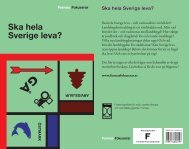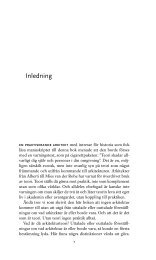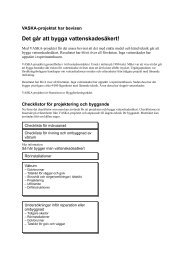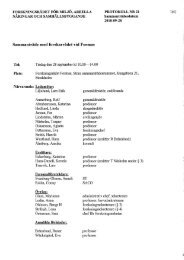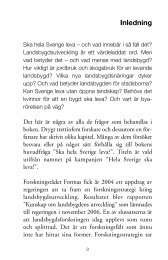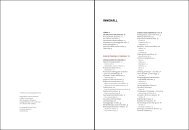Ladda ned - Formas
Ladda ned - Formas
Ladda ned - Formas
You also want an ePaper? Increase the reach of your titles
YUMPU automatically turns print PDFs into web optimized ePapers that Google loves.
man’s diet” by the indigenous ethnic groups produced<br />
deleterious health effects. Similarly, studies<br />
among the Afro-Caribbean community in Great<br />
Britain shows that the traditional West Indian diet<br />
is far much healthier than the adopted British diet<br />
which has been implicated in the rising levels of<br />
obesity 19 . Obesity is the fastest growing problem<br />
worldwide 20 . It is a<br />
result of changes in<br />
diet, physical activity,<br />
health, nutrition and<br />
social and economic<br />
changes collectively<br />
known as the nutrition<br />
transition 21 .<br />
There is evidence that<br />
shows that chronic diseases<br />
rise and reach<br />
epidemic proportions<br />
if the nutrition transition<br />
is left unheeded<br />
[Walter Dietz, director<br />
of nutrition and physi-<br />
”Eating from the other.”<br />
cal activity at Centre for Disease Control and Prevention<br />
(CDC)]. In marginalised groups such as migrant<br />
groups this nutrition transition can take place<br />
within half a generation for the reasons outli<strong>ned</strong><br />
below. The burden of chronic diseases, such as<br />
type 2 diabetes 22 , hypertension, cardiovascular diseases<br />
23 are documented in Sweden as being rather<br />
prevalent in immigrants from outside the Nordic<br />
countries.<br />
The myth of food multiculturalism<br />
In countries where immigrants have co-existed<br />
with the indigenous population, the food habits<br />
and the ingredients required to make these dishes<br />
have been incorporated into the supermarkets. This<br />
is most prominent in countries like Great Britain,<br />
USA and France 24 . Just recently Robin Cook stated<br />
that chicken thika masala 25 was now Britain’s national<br />
dish at the same time Robin Cook asked how a<br />
foreign dish could have become the nations national<br />
dish. This statement raised the question of whether<br />
acceptance of foreign dishes meant also accepting<br />
the migrant or is it just enough to accept the food<br />
for the “other’s needs”. It is evident in the chicken<br />
curry case that the dish itself is suitable but perhaps<br />
not the people behind the dish. One could parallel<br />
this example with the kebab in Sweden that has<br />
become a common dish in the lives of many Swedes.<br />
To what extent are the makers of kebab an accepted<br />
integrated part of the Swedish society? Ironically, to<br />
make some of these dishes acceptable, modifications<br />
are made to suit the palate of the host, usually more<br />
energy dense, and a situation of reverse parasitism.<br />
79<br />
Spicing up the supermarkets with<br />
the “other’s” food<br />
In almost all the supermarkets in Sweden, one will<br />
find a wide range of not only exotic spices26 but<br />
also fruits and vegetables. The “spices” liven up,<br />
the indigenous diet. However, the price of these<br />
exotic spices in the mainstream supermarkets is<br />
prohibitively expensive<br />
for the migrant<br />
and is mostly enjoyed<br />
by the “other”. The<br />
supermarkets that specialise<br />
in bulk packaging<br />
usually do not carry a<br />
wide range of multicultural<br />
ethnic foods<br />
let alone quality nutrient<br />
foods. In the end<br />
“what is good” is expensive<br />
and located in the<br />
“mainstream Swedish<br />
milieu”. These factors<br />
combi<strong>ned</strong> if not taken<br />
into account now, will in 20 years time be regarded<br />
as attributing factors very specific for migrant<br />
diets and health in Sweden.<br />
Photo: Nils Aria<br />
Narcissistic hospitality and the<br />
aging migrant in Sweden<br />
It is estimated that 11% of the Swedish population<br />
is of migrant stock and still increasing 27 . Evidently<br />
it seems easier to accept and eat food of the “other”<br />
(narcissistic hospitality) than to accommodate the<br />
persons behind the food. This brings into question<br />
the future fate of aging migrants in Sweden<br />
with bipalatal food habits. Since Sweden has had<br />
non-existent colonial links the mobility of foods,<br />
knowledge and practice about migrant diets still<br />
remain rudimentary. Notwithstanding, migrants<br />
in Sweden, are observed to practice bipalatalism,<br />
searching for familiar foods in so called “migrant<br />
shops” or by hauling back food from their<br />
countries. How much is known about the migrants’<br />
diet in relation to migrant health. This question is<br />
important to elucidate especially as the migrant<br />
stock reaches elderly home stages (see Albin et al.,;<br />
Pudiaric et al.,). Studies have shown that, diseases<br />
of poverty, such as under nutrition, and over nutrition<br />
are common in the elderly, especially when<br />
coupled with socio-cultural, psychological and<br />
economic factors 28 . Are the retirement homes in<br />
Sweden acculturated to caring for elderly migrant<br />
stock that has bipalatal food habits?<br />
Concluding remarks<br />
“Will the legacy of our generation be more than a series<br />
of broken promises” Nelson Mandela




